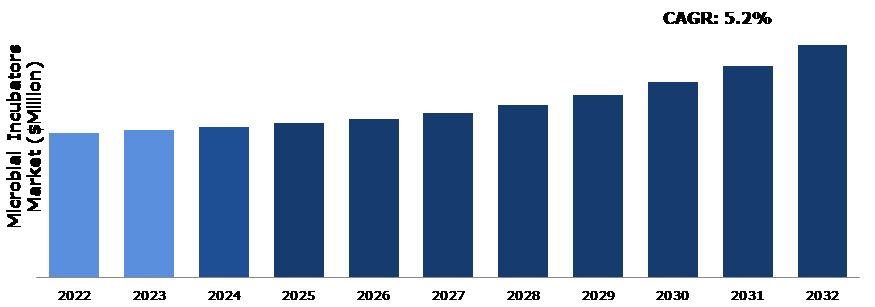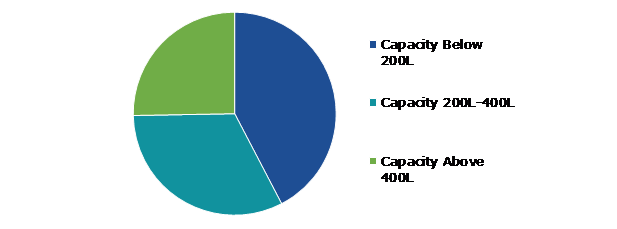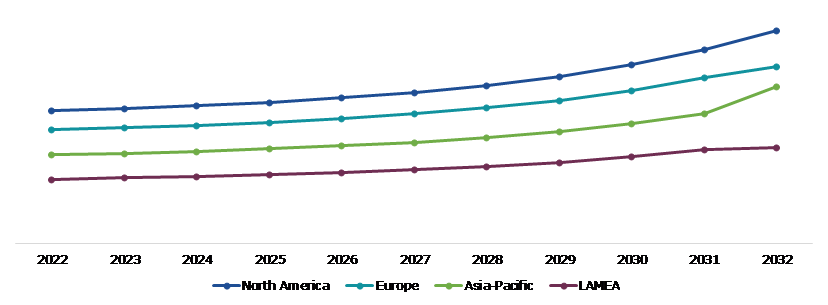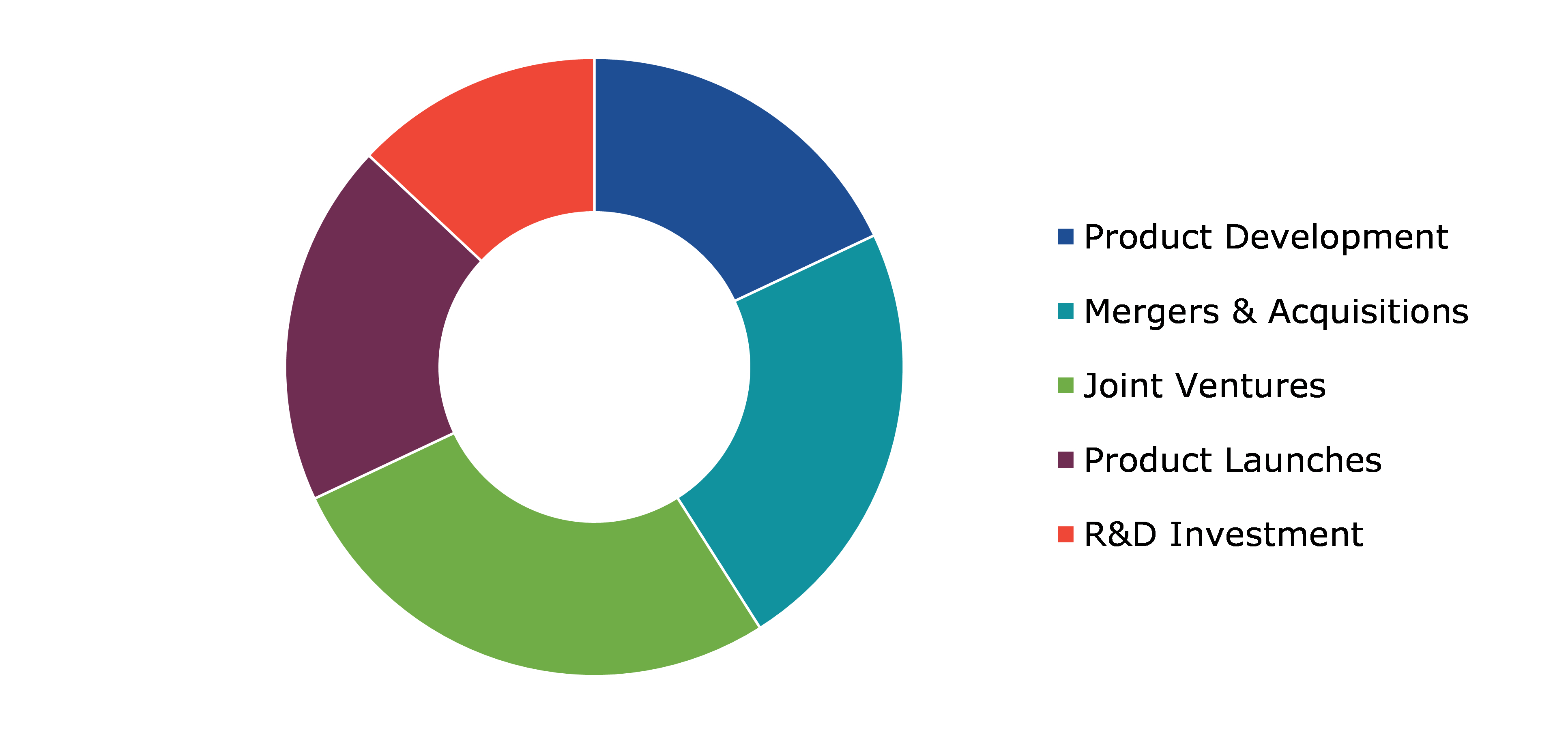Microbial Incubators Market Report
RA09214
Microbial Incubators Market by Type (Capacity Below 200L, Capacity 200L-400L, and Capacity Above 400L), Application (Hospitals, Laboratories, and Others), and Region (North America, Europe, Asia-Pacific, and LAMEA): Global Opportunity Analysis and Industry Forecast, 2023-2032
Microbial Incubators Overview
Microbial incubators, also known as ‘heat-only’ or ‘standard’ incubators, are equipped with heating elements, and can only provide culture temperatures above ambient temperature. If the ambient temperature in the laboratory is around 22°C, incubation temperatures of above around 27°C or even 30°C can only be achieved. Standard incubators provide precise temperature control and uniformity for a variety of everyday applications. Incubators of various sizes are available with the following features: decontamination program, locking mechanism, alarm, digital display, and transparent door for visual inspection without heat loss. Standard incubators utilize either gravity convection, mechanical convection, or dual convection airflow technology, with operator selectable fan speeds..
Global Microbial Incubators Market Analysis
The global microbial incubators market size was $315.2 million in 2022 and is predicted to grow with a CAGR of 5.2%, by generating a revenue of $508.5 million by 2032.
Source: Research Dive Analysis
Increasing Focus on Biomedical Research and Life Sciences to Drive the Market Growth
The focus on biomedical research and life sciences is projected to be the key factor driving the growth of the microbial incubators market. Microbial incubators play an important role in these fields by providing a controlled environment for culturing and researching microorganisms. Microbial incubators are essential for culturing microorganisms such as bacteria, yeast, and fungi. Researchers in the fields of biomedical and life sciences use these incubators to create optimal conditions for the growth and study of various microorganisms. This is especially important for experiments related to drug discovery, disease understanding, and genetic research. In biomedical research, cell culture is a fundamental technique for studying cell behavior, drug responses, and disease mechanisms. Microbial incubators provide a controlled environment for maintaining cell cultures, ensuring the necessary conditions for cell growth and survival. The pharmaceutical industry relies heavily on microbial incubators for drug R&D. These incubators allow researchers to test the effectiveness and safety of potential drugs by studying their effects on microorganisms and cell cultures under controlled conditions. The development of vaccines often involves the growth of microorganisms or cell cultures. Microbial incubators are crucial for providing the precise environmental conditions required for the production of vaccines and the study of vaccine candidates. Governments, academic institutions, and private companies are increasing their investments in biomedical research and life sciences. This surge in funding has led to an expansion of research activities, thereby driving the demand for advanced laboratory equipment, including microbial incubators. All these factors are anticipated to drive the microbial incubators market growth in the upcoming years.
High Cost of Microbial Incubators to Restrain the Market Growth
One of the major barriers in the microbial incubator market is the high initial cost associated with purchasing and installing advanced culture systems. For example, achieving precise temperature and humidity control can be economically challenging for small, budget-constrained research facilities and laboratories. In addition to the initial investment, the ongoing maintenance costs of microbial incubators can be significant requiring careful budgeting and proactive management to ensure optimal functionality and longevity. Regular calibration, verification, and maintenance are essential to ensure the accuracy and reliability of incubator performance. These costs can strain the budgets of research institutions, especially those with limited resources. Laboratories, especially in academic and medical settings, often face limited space constraints. The physical space requirements of large microbial incubators can be challenging, especially when laboratories need to accommodate multiple devices for different experiments and research activities.
Technological Advancements to Drive Excellent Opportunities in the Market
Integrating advanced features such as smart sensors, real-time monitoring, and connectivity options presents opportunities for microbial incubator manufacturers. Improved data collection, remote monitoring, and Internet of Things (IoT) capabilities improve the efficiency of the research process and give researchers better control over their experiments. Real-time monitoring capabilities allow researchers to remotely track and adjust culture parameters such as temperature, humidity, and CO2 levels. Integrating smart sensors and automation capabilities can streamline microbial culture management and reduce the need for manual intervention. Internet of Things (IoT) connectivity enables seamless communication between microbial incubators and other laboratory equipment or central systems. The intuitive and user-friendly interface improves the user experience and reduces the learning curve for operating the microbial incubator. All these factors are expected to drive the microbial incubator market expansion in the upcoming years.
Global Microbial Incubators Market Share, by Type, 2022
Source: Research Dive Analysis
The capacity below 200L sub-segment accounted for the highest market share in 2022. Larger capacity microbial incubators are often required in bioprocessing applications, especially in the production of biotherapeutics, vaccines, and other biopharmaceuticals. The need to scale up production processes to meet growing demand is projected to drive the adoption of 200L+ incubators. With advancements in cell culture techniques and the need for larger-scale cell culture experiments, researchers may opt for incubators with capacities exceeding 200L. This is particularly relevant in biotechnology and pharmaceutical research. Industries involved in large-scale microbiological applications, such as industrial microbiology for fermentation and production of microbial products, require incubators with capacities of 200L and above to accommodate larger volumes and maintain consistent conditions. Laboratories engaged in high-throughput screening, where multiple experiments are conducted simultaneously, may benefit from larger incubators. In medical and clinical research, the use of larger incubators becomes crucial for in vitro fertilization (IVF) procedures and tissue culture experiments, where maintaining optimal conditions for cell growth is essential.
Global Microbial Incubators Market Share, by Application, 2022
Source: Research Dive Analysis
The hospitals sub-segment accounted for the highest market share in 2022. Hospitals routinely perform microbiological testing to identify and analyze pathogens, bacteria, and other microorganisms. Microbial incubators provide controlled conditions for culturing and observing microbial cultures, helping to accurately diagnose infectious diseases. Hospitals conduct clinical studies and research that examine microorganisms for diagnostic and therapeutic purposes. Microbial incubators are essential for maintaining cultures and conducting experiments in the controlled environment of hospital laboratories. Hospitals that handle reproductive medicine such as in vitro fertilization use microbial incubators to maintain cell cultures and study the microbiome. These studies are important for understanding the factors that influence fertility and reproductive health. Hospitals use microbial incubators for cell and tissue culture applications. This is especially true for in-hospital cancer research, drug testing, and research related to regenerative medicine.
Global Microbial Incubators Market Size & Forecast, by Region, 2022-2032 ($Million)
Source: Research Dive Analysis
The North America microbial incubators market generated the highest revenue in 2022. The strong presence of research institutes, universities, and biotechnology companies in North America has led to an increase in demand for microbial incubators. Ongoing biomedical and life science research projects, including studies of genetics, drug development, and disease mechanisms, are increasing the need for controlled environments for microbial culture. North America's pharmaceutical and biotechnology industries are major contributors to the demand for microbial incubators. These industries make extensive use of incubators for drug discovery, development, and manufacturing, creating a robust market for advanced microbial culture systems. With the increasing focus on cell-based research and biologics development, the demand for microbial incubators is increasing. These incubators play a key role in providing optimal conditions for cell culture research, which is important for drug discovery and regenerative medicine. Support from government agencies and research grants for scientific endeavors in North America are contributing to the expansion of the microbial incubator market. Investments in research infrastructure and equipment, including advanced incubation systems, are projected to drive the regional market growth in the future.
Competitive Scenario in the Global Microbial Incubators Market
Investment and agreement are common strategies followed by major market players. For instance, in January 2021, Memmert increased the temperature range of its Peltier-cooled incubators, the IPPeco 1400L and 2200L incubator line, from +15 to +60°C to the new range of 0 to +70°C in order to improve operating flexibility.
Source: Research Dive Analysis
Some of the companies operating in the microbial incubators market General Electric Company, Atom Medical Corporation, Panasonic, Thermofisher Inc., Natus Medical Incorporated, Phoenix Medical Systems, Drägerwerk AG, Cobams plc., Sartorius AG, Binderholz GmbH, and VWR Lab Products Pvt. Ltd.
| Aspect | Particulars |
| Historical Market Estimations | 2020-2021 |
| Base Year for Market Estimation | 2022 |
| Forecast Timeline for Market Projection | 2023-2032 |
| Geographical Scope | North America, Europe, Asia-Pacific, and LAMEA |
| Segmentation by Type |
|
| Segmentation by Application |
|
| Key Companies Profiled |
|
Q1. What is the size of the global microbial incubators market?
A. The size of the global microbial incubators market was over $ 315.2 million in 2022 and is projected to reach $508.5 million by 2032.
Q2. Which are the major companies in the microbial incubators market?
A. Thermofisher Inc. and Natus Medical Incorporated are some of the key players in the global microbial incubators market.
Q3. Which region, among others, possesses greater investment opportunities in the future?
A. Asia-Pacific possesses great investment opportunities for investors in the future.
Q4. What will be the growth rate of the Asia-Pacific microbial incubators market?
A. The Asia-Pacific microbial incubators market is anticipated to grow at 6.2% CAGR during the forecast period.
Q5. What are the strategies opted by the leading players in this market?
A. Agreement and investment are the two key strategies opted by the operating companies in this market.
Q6. Which companies are investing more on R&D practices?
A. General Electric Company, Atom Medical Corporation, Panasonic, Thermofisher Inc, and Natus Medical Incorporated. are the companies investing more on R&D activities for developing new products and technologies.
1. Research Methodology
1.1. Desk Research
1.2. Real time insights and validation
1.3. Forecast model
1.4. Assumptions and forecast parameters
1.5. Market size estimation
1.5.1. Top-down approach
1.5.2. Bottom-up approach
2. Report Scope
2.1. Market definition
2.2. Key objectives of the study
2.3. Report overview
2.4. Market segmentation
2.5. Overview of the impact of COVID-19 on global Microbial Incubators Market
3. Executive Summary
4. Market Overview
4.1. Introduction
4.2. Growth impact forces
4.2.1. Drivers
4.2.2. Restraints
4.2.3. Opportunities
4.3. Market value chain analysis
4.3.1. List of raw material suppliers
4.3.2. List of manufacturers
4.3.3. List of distributors
4.4. Innovation & sustainability matrices
4.4.1. Technology matrix
4.4.2. Regulatory matrix
4.5. Porter’s five forces analysis
4.5.1. Bargaining power of suppliers
4.5.2. Bargaining power of consumers
4.5.3. Threat of substitutes
4.5.4. Threat of new entrants
4.5.5. Competitive rivalry intensity
4.6. PESTLE analysis
4.6.1. Political
4.6.2. Economical
4.6.3. Social
4.6.4. Legal
4.6.5. Technological
4.6.6. Environmental
4.7. Impact of COVID-19 on Microbial Incubators market
4.7.1. Pre-covid market scenario
4.7.2. Post-covid market scenario
5. Microbial Incubators Market Analysis, by Type
5.1. Overview
5.2. Capacity Below 200L
5.2.1. Definition, key trends, growth factors, and opportunities
5.2.2. Market size analysis, by region, 2022-2032
5.2.3. Market share analysis, by country, 2022-2032
5.3. Capacity 200L-400L
5.3.1. Definition, key trends, growth factors, and opportunities
5.3.2. Market size analysis, by region, 2022-2032
5.3.3. Market share analysis, by country, 2022-2032
5.4. Capacity Above 400L
5.4.1. Definition, key trends, growth factors, and opportunities
5.4.2. Market size analysis, by region, 2022-2032
5.4.3. Market share analysis, by country, 2022-2032
5.5. Research Dive Exclusive Insights
5.5.1. Market attractiveness
5.5.2. Competition heatmap
6. Microbial Incubators Market Analysis, by Application
6.1. Hospitals
6.1.1. Definition, key trends, growth factors, and opportunities
6.1.2. Market size analysis, by region, 2022-2032
6.1.3. Market share analysis, by country, 2022-2032
6.2. Laboratories
6.2.1. Definition, key trends, growth factors, and opportunities
6.2.2. Market size analysis, by region, 2022-2032
6.2.3. Market share analysis, by country, 2022-2032
6.3. Others
6.3.1. Definition, key trends, growth factors, and opportunities
6.3.2. Market size analysis, by region, 2022-2032
6.3.3. Market share analysis, by country, 2022-2032
6.4. Research Dive Exclusive Insights
6.4.1. Market attractiveness
6.4.2. Competition heatmap
7. Microbial Incubators Market, by Region
7.1. North America
7.1.1. U.S.
7.1.1.1. Market size analysis, by Type, 2022-2032
7.1.1.2. Market size analysis, by Application, 2022-2032
7.1.2. Canada
7.1.2.1. Market size analysis, by Type, 2022-2032
7.1.2.2. Market size analysis, by Application, 2022-2032
7.1.3. Mexico
7.1.3.1. Market size analysis, by Type, 2022-2032
7.1.3.2. Market size analysis, by Application, 2022-2032
7.1.4. Research Dive Exclusive Insights
7.1.4.1. Market attractiveness
7.1.4.2. Competition heatmap
7.2. Europe
7.2.1. Germany
7.2.1.1. Market size analysis, by Type, 2022-2032
7.2.1.2. Market size analysis, by Application, 2022-2032
7.2.2. UK
7.2.2.1. Market size analysis, by Type, 2022-2032
7.2.2.2. Market size analysis, by Application, 2022-2032
7.2.3. France
7.2.3.1. Market size analysis, by Type, 2022-2032
7.2.3.2. Market size analysis, by Application, 2022-2032
7.2.4. Spain
7.2.4.1. Market size analysis, by Type, 2022-2032
7.2.4.2. Market size analysis, by Application, 2022-2032
7.2.5. Italy
7.2.5.1. Market size analysis, by Type, 2022-2032
7.2.5.2. Market size analysis, by Application, 2022-2032
7.2.6. Rest of Europe
7.2.6.1. Market size analysis, by Type, 2022-2032
7.2.6.2. Market size analysis, by Application, 2022-2032
7.2.7. Research Dive Exclusive Insights
7.2.7.1. Market attractiveness
7.2.7.2. Competition heatmap
7.3. Asia-Pacific
7.3.1. China
7.3.1.1. Market size analysis, by Type, 2022-2032
7.3.1.2. Market size analysis, by Application, 2022-2032
7.3.2. Japan
7.3.2.1. Market size analysis, by Type, 2022-2032
7.3.2.2. Market size analysis, by Application, 2022-2032
7.3.3. India
7.3.3.1. Market size analysis, by Type, 2022-2032
7.3.3.2. Market size analysis, by Application, 2022-2032
7.3.4. Australia
7.3.4.1. Market size analysis, by Type, 2022-2032
7.3.4.2. Market size analysis, by Application, 2022-2032
7.3.5. South Korea
7.3.5.1. Market size analysis, by Type, 2022-2032
7.3.5.2. Market size analysis, by Application, 2022-2032
7.3.6. Rest of Asia-Pacific
7.3.6.1. Market size analysis, by Type, 2022-2032
7.3.6.2. Market size analysis, by Application, 2022-2032
7.3.7. Research Dive Exclusive Insights
7.3.7.1. Market attractiveness
7.3.7.2. Competition heatmap
7.4. LAMEA
7.4.1. Brazil
7.4.1.1. Market size analysis, by Type, 2022-2032
7.4.1.2. Market size analysis, by Application, 2022-2032
7.4.2. Saudi Arabia
7.4.2.1. Market size analysis, by Type, 2022-2032
7.4.2.2. Market size analysis, by Application, 2022-2032
7.4.3. UAE
7.4.3.1. Market size analysis, by Type, 2022-2032
7.4.3.2. Market size analysis, by Application, 2022-2032
7.4.4. South Africa
7.4.4.1. Market size analysis, by Type, 2022-2032
7.4.4.2. Market size analysis, by Application, 2022-2032
7.4.5. Rest of LAMEA
7.4.5.1. Market size analysis, by Type, 2022-2032
7.4.5.2. Market size analysis, by Application, 2022-2032
7.4.6. Research Dive Exclusive Insights
7.4.6.1. Market attractiveness
7.4.6.2. Competition heatmap
8. Competitive Landscape
8.1. Top winning strategies, 2022
8.1.1. By strategy
8.1.2. By year
8.2. Strategic overview
8.3. Market share analysis, 2022
9. Company Profiles
9.1. General Electric Company
9.1.1. Overview
9.1.2. Business segments
9.1.3. Product portfolio
9.1.4. Financial performance
9.1.5. Recent developments
9.1.6. SWOT analysis
9.2. Atom Medical Corporation, Panasonic
9.2.1. Overview
9.2.2. Business segments
9.2.3. Product portfolio
9.2.4. Financial performance
9.2.5. Recent developments
9.2.6. SWOT analysis
9.3. Thermofisher Inc.
9.3.1. Overview
9.3.2. Business segments
9.3.3. Product portfolio
9.3.4. Financial performance
9.3.5. Recent developments
9.3.6. SWOT analysis
9.4. Natus Medical Incorporated
9.4.1. Overview
9.4.2. Business segments
9.4.3. Product portfolio
9.4.4. Financial performance
9.4.5. Recent developments
9.4.6. SWOT analysis
9.5. Phoenix Medical Systems
9.5.1. Overview
9.5.2. Business segments
9.5.3. Product portfolio
9.5.4. Financial performance
9.5.5. Recent developments
9.5.6. SWOT analysis
9.6. Drägerwerk AG
9.6.1. Overview
9.6.2. Business segments
9.6.3. Product portfolio
9.6.4. Financial performance
9.6.5. Recent developments
9.6.6. SWOT analysis
9.7. Cobams plc.
9.7.1. Overview
9.7.2. Business segments
9.7.3. Product portfolio
9.7.4. Financial performance
9.7.5. Recent developments
9.7.6. SWOT analysis
9.8. Sartorius AG
9.8.1. Overview
9.8.2. Business segments
9.8.3. Product portfolio
9.8.4. Financial performance
9.8.5. Recent developments
9.8.6. SWOT analysis
9.9. Binderholz GmbH
9.9.1. Overview
9.9.2. Business segments
9.9.3. Product portfolio
9.9.4. Financial performance
9.9.5. Recent developments
9.9.6. SWOT analysis
9.10. VWR Lab Products Pvt. Ltd
9.10.1. Overview
9.10.2. Business segments
9.10.3. Product portfolio
9.10.4. Financial performance
9.10.5. Recent developments
9.10.6. SWOT analysis
Personalize this research
- Triangulate with your own data
- Request your format and definition
- Get a deeper dive on a specific application, geography, customer or competitor
- + 1-888-961-4454 Toll - Free
- support@researchdive.com






